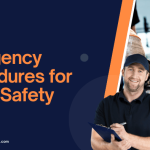Table of Contents
- Understanding the Risks of Boiler Systems
- Regular Inspections and Maintenance
- Install Carbon Monoxide Detectors
- Keep the Area Around the Boiler Clear
- Properly Ventilate Your Boiler Room
- Use Quality Fuel Sources
- Understand Your Boiler’s Safety Features
- Know the Signs of Trouble
- Educate Your Household
- Have an Emergency Plan
Boilers play a crucial role in heating our homes and businesses, but they can also pose significant fire risks if not managed properly. This guide presents ten essential fire safety tips to ensure your boiler system operates safely. Let’s dive in!
Understanding the Risks of Boiler Systems
Boilers operate under high pressure and temperature, which can lead to dangerous situations if not appropriately maintained. Common risks include explosions, fires, and carbon monoxide leaks. According to the National Fire Protection Association (NFPA), heating equipment is responsible for a significant percentage of fires. Understanding these risks is the first step in ensuring your boiler system remains safe.
“Awareness is the first step to prevention. By understanding the risks associated with your boiler system, you can take proactive measures to mitigate them.”
Regular Inspections and Maintenance
Regular inspections and maintenance are vital to the longevity and safety of your boiler system. Schedule annual professional inspections to ensure all components are in good working order. During these inspections, a qualified technician will check for leaks, ensure proper combustion, and clean critical components. Keeping a maintenance log can help you track service dates and any issues identified.
| Maintenance Task | Frequency |
|---|---|
| Professional Inspection | Annually |
| Water Level Check | Monthly |
| Pressure Relief Valve Check | Quarterly |
| Flue and Vent Inspection | Annually |
For more on boiler maintenance, refer to our article on Essential Boiler Maintenance Tips.
“A well-maintained boiler is the cornerstone of a safe heating system. Don’t neglect those inspections!”
Install Carbon Monoxide Detectors
Carbon monoxide (CO) is a colorless, odorless gas that can be deadly. Install CO detectors in areas near your boiler, especially in sleeping areas. Ensure they are working by testing them monthly and replacing batteries as needed. According to the Centers for Disease Control and Prevention (CDC), CO poisoning can occur from faulty heating systems, making these detectors essential for safety.
“Carbon monoxide detectors are your first line of defense against a silent threat. Don’t compromise on safety.”
Keep the Area Around the Boiler Clear
It’s crucial to maintain a clutter-free environment around your boiler. Flammable materials, such as paper, cloth, or chemicals, should be stored away from the unit. Create a designated safe zone around your boiler with at least three feet of clearance. This not only reduces fire risk but also allows for easier access during maintenance.
“A clean area around your boiler is not just good housekeeping; it’s a fundamental fire safety practice.”
Properly Ventilate Your Boiler Room
Ventilation is key to preventing dangerous gas buildup. Ensure that your boiler room has adequate ventilation to allow fresh air in and exhaust gases out. Use vents or fans to improve airflow, especially in confined spaces. Check that all vents are clear and operational during your regular inspections. For more on ventilation requirements, check our guide on Essential Boiler Location Guidelines.
“Proper ventilation is crucial. Don’t let your boiler room become a hazardous zone!”
Use Quality Fuel Sources
The type of fuel used in your boiler can significantly impact safety. Always use high-quality fuel that meets the manufacturer’s specifications. Poor-quality fuel can lead to incomplete combustion, increasing the risk of fire and producing harmful gases. If you’re unsure about the fuel you’re using, consult your boiler’s manual or a professional technician.
“Fuel quality matters. Always choose the best to ensure your boiler operates safely.”
Understand Your Boiler’s Safety Features
Modern boilers come equipped with several safety features designed to prevent disasters. Familiarize yourself with these features, such as pressure relief valves, safety shut-off switches, and temperature sensors. Knowing how these mechanisms work can help you respond effectively in case of an emergency. Make sure these safety features are checked and tested regularly during maintenance.
“Knowledge is power! Understand your boiler’s safety features to enhance your response in emergencies.”
Know the Signs of Trouble
Awareness of potential warning signs can help you catch issues before they escalate. Look for:
- Unusual noises (banging, hissing)
- Leakages around the boiler
- Discoloration of the boiler’s exterior
- Foul odors, especially near the gas line
If you notice any of these signs, contact a professional immediately. Early detection can prevent serious accidents. For more troubleshooting tips, see our article on 7 Reasons Your Boiler Isn’t Heating and How to Fix It.
“Stay alert! Early detection of issues can save your boiler and your home.”
Educate Your Household
Everyone in your home should be aware of basic boiler safety practices. Teach your household members about the importance of maintaining a clear area around the boiler, recognizing warning signs, and understanding the function of safety devices. Having a common knowledge base can be crucial during emergencies.
“Education is the best prevention. Make sure everyone in your household knows boiler safety.”
Have an Emergency Plan
Finally, it’s essential to have an emergency plan in place. This plan should include:
- Evacuation routes in the event of a fire
- Designated meeting points outside the home
- Emergency contact numbers
Ensure everyone knows the plan and conducts regular fire drills. Being prepared can save lives.
“Preparation is key! An emergency plan can make all the difference when seconds count.”
By following these ten essential tips, you can significantly reduce the fire risks associated with your boiler system. Regular maintenance, awareness of safety features, and education are key to keeping your home safe. For more information on fire safety, visit the NFPA website.
Stay safe and warm!





